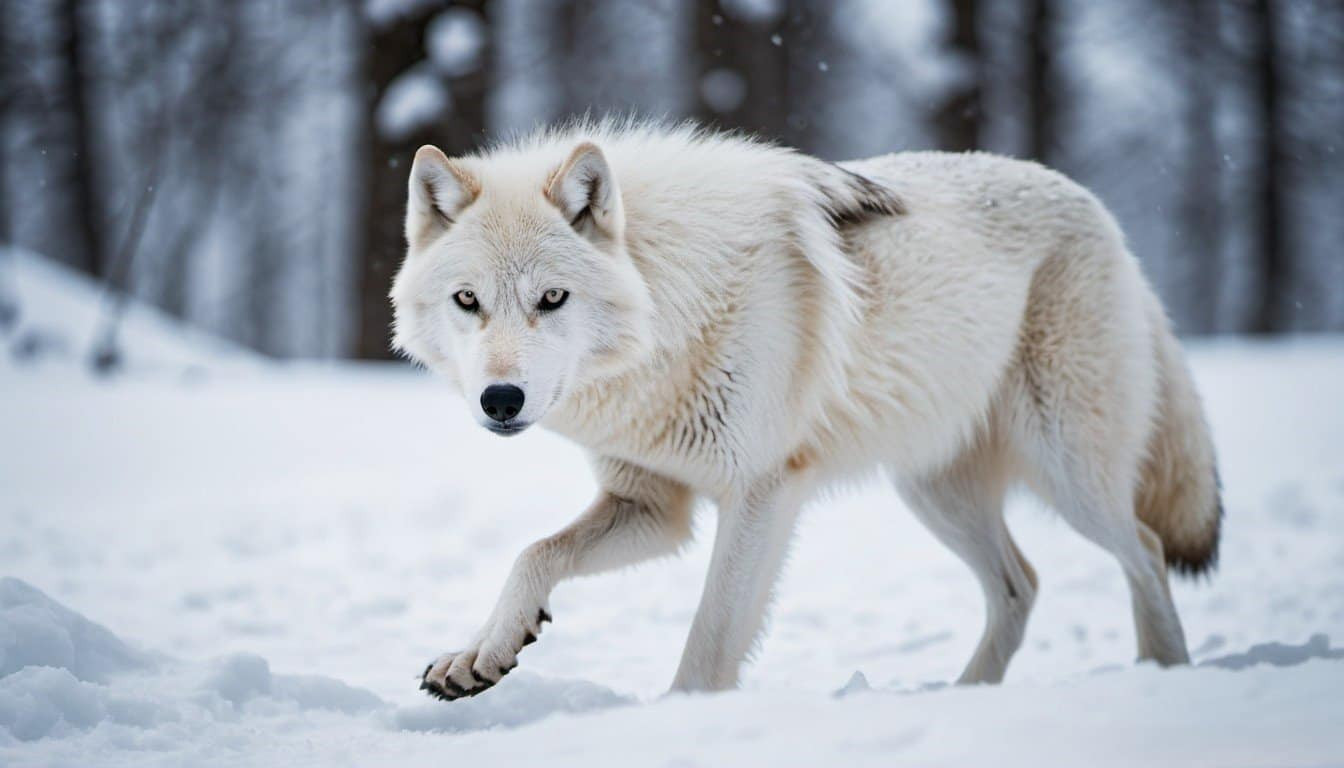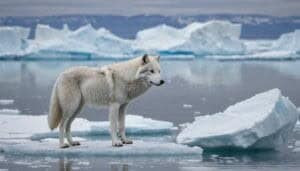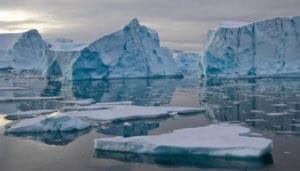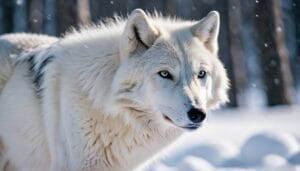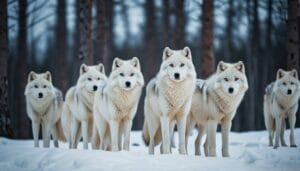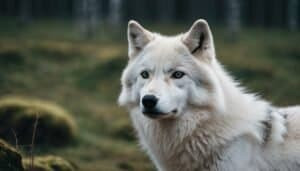Introduction
Arctic wolves face unique challenges in their harsh environment, particularly regarding hunting efficiency. Snow cover significantly impacts their ability to hunt, influencing their mobility, prey visibility, and overall survival strategies
This article explores how various snow conditions affect Arctic wolves, examining their adaptations, hunting techniques, and the broader ecosystem dynamics. Understanding these factors provides insight into the resilience and adaptability of these magnificent predators in one of the most extreme habitats on Earth
Mobility and Hunting Efficiency in Various Snow Conditions
Arctic wolves’ hunting efficiency is closely tied to their ability to navigate through varying snow conditions. Snow depth and consistency can either hinder or aid their mobility, impacting their ability to successfully hunt prey
Challenges of Deep Snow
Deep snow presents significant challenges for Arctic wolves. Thick layers of snow can slow down their movement, making it harder to chase and capture prey. The wolves expend more energy moving through deep snow, which can lead to quicker fatigue and reduced hunting success
Additionally, deep snow can obscure the trails of prey animals, making it difficult for wolves to track them. These challenges necessitate adaptations and strategies to cope with the demanding conditions
Navigating Shallow Snow
In contrast, shallow snow offers Arctic wolves a more manageable hunting environment. With less resistance to their movement, wolves can cover ground more quickly and efficiently. This increased mobility allows them to pursue prey with greater success
Shallow snow also makes it easier for wolves to detect and follow the tracks of their prey, enhancing their ability to hunt effectively. However, shallow snow conditions are not always guaranteed, and wolves must be adaptable to changing environments
The Cost of Movement in Deep Snow
The energy expenditure required for movement in deep snow is a critical factor influencing Arctic wolves’ hunting efficiency. Moving through deep snow requires more effort and energy, which can deplete the wolves’ reserves more quickly
This increased energy cost can affect their overall health and ability to sustain prolonged hunting activities. In extreme cases, the inability to secure enough food due to high energy expenditure can threaten the wolves’ survival, highlighting the importance of efficient energy management in harsh conditions
Efficiency in Sparse Snow Areas
Sparse snow areas, where the snow cover is minimal, offer the most favorable conditions for Arctic wolves. These areas allow for effortless movement and minimal energy expenditure, enabling wolves to hunt more effectively
The lack of deep snow also improves visibility and tracking of prey, further enhancing hunting success. However, such conditions can be rare in the Arctic, and wolves must take advantage of these opportunities when they arise
The ability to adapt to varying snow conditions is crucial for the survival and hunting efficiency of Arctic wolves
Prey and Hunting Techniques of Arctic Wolves
Arctic wolves have evolved to become adept hunters, with their prey preferences and hunting techniques finely tuned to their harsh environment. Understanding these aspects sheds light on how they thrive in such an extreme habitat
Common Prey Species
Arctic wolves primarily hunt large mammals such as muskoxen and Arctic hares. Muskoxen provide a significant source of nutrition due to their size, but hunting them requires coordination and strategy
Arctic hares, being smaller, are more abundant and easier to catch, providing a reliable food source. During the summer months, wolves may also hunt birds, lemmings, and other small mammals
The availability of these prey species is influenced by the season and snow conditions, directly impacting the wolves’ hunting success
Hunting Techniques
Arctic wolves employ various hunting techniques depending on their prey and the environment. For larger prey like muskoxen, wolves hunt in packs, using teamwork to isolate and take down an individual
They often rely on stamina and endurance, chasing their prey over long distances until it becomes exhausted. For smaller prey such as Arctic hares, wolves hunt alone or in pairs, using stealth and speed to surprise their quarry. These techniques demonstrate the wolves’ adaptability and strategic thinking in different hunting scenarios
Prey Movement Patterns
The movement patterns of prey animals are significantly influenced by snow cover. During deep snow conditions, prey animals like muskoxen may move to areas with less snow to conserve energy, while smaller prey like hares may remain hidden under the snow, creating a challenge for the wolves
Understanding these movement patterns helps Arctic wolves anticipate where to find their prey, improving their hunting efficiency. Wolves often follow prey trails and use their keen sense of smell to track hidden animals, demonstrating their adaptability to changing prey behaviors
Prey Hiding Strategies
Prey animals in the Arctic have developed various hiding strategies to avoid predators like Arctic wolves. For instance, Arctic hares use their white fur to blend into the snowy landscape, making them difficult to spot. Muskoxen form defensive circles with their young in the center to protect against wolf attacks
These strategies require wolves to be innovative and persistent in their hunting methods. By understanding and countering these tactics, Arctic wolves improve their chances of a successful hunt, showcasing their intelligence and adaptability
Adaptations and Survival Strategies
Arctic wolves have developed remarkable physical and behavioral adaptations that enable them to survive and thrive in the extreme Arctic environment. These adaptations are crucial for their hunting efficiency and overall survival
Physical Adaptations
Arctic wolves possess several physical adaptations that help them endure harsh conditions. Their thick fur provides insulation against freezing temperatures, while their padded paws are designed for walking on snow and ice
Additionally, their strong, muscular build aids in traversing rugged terrain and deep snow. These physical characteristics are essential for maintaining their hunting efficiency, as they allow the wolves to move swiftly and comfortably in their environment
Behavioral Adaptations
Behavioral adaptations are equally important for Arctic wolves’ survival. They have developed hunting strategies that involve teamwork and communication within the pack. Wolves use vocalizations and body language to coordinate their actions during a hunt, increasing their chances of success
Moreover, they have learned to time their hunts to coincide with the activity patterns of their prey, maximizing their hunting efficiency. These behavioral adaptations highlight the wolves’ intelligence and social structure, which are vital for their survival
Energy Conservation Techniques
In the harsh Arctic environment, conserving energy is crucial for survival. Arctic wolves have developed several techniques to minimize energy expenditure. During extreme cold or when food is scarce, wolves reduce their activity levels to conserve energy
They also take advantage of resting periods between hunts to recover and maintain their strength. Additionally, wolves strategically choose hunting grounds that offer the best chances of success with the least energy expenditure
These energy conservation techniques are vital for enduring the long, harsh winters and ensuring the wolves’ survival
Finding and Following Prey Tracks
Tracking prey through snow is a critical skill for Arctic wolves. They use their keen sense of smell to detect and follow the scent of prey, even when it is hidden under snow. Wolves also look for visual cues, such as tracks and disturbances in the snow, to locate their prey
This ability to find and follow prey tracks is essential for their hunting efficiency, especially in deep snow conditions where visual detection is challenging. By mastering these tracking skills, Arctic wolves increase their chances of a successful hunt
Snow Cover Influence on Prey Visibility and Behavior
Snow cover significantly impacts both the visibility of prey and their behavior, affecting Arctic wolves’ hunting strategies and success rates. Understanding these dynamics is key to comprehending how wolves adapt to their environment
Camouflage and Detection
Snow cover provides excellent camouflage for many prey species, making it difficult for Arctic wolves to spot them. Animals like Arctic hares have white fur that blends seamlessly with the snowy landscape, reducing their visibility to predators
This natural camouflage forces wolves to rely more on their sense of smell and hearing to locate prey. The ability to detect hidden prey is crucial for hunting efficiency, and wolves have developed acute senses to compensate for the visual challenges posed by snow cover
Hunting in Different Snow Conditions
Different snow conditions require Arctic wolves to adjust their hunting tactics. In deep snow, wolves may struggle to move quickly, while prey animals may use the snow to hide or escape. In shallow snow, both wolves and their prey can move more freely, leading to different interaction dynamics
Wolves must be versatile in their hunting approaches, adapting to whether they face deep, powdery snow or hard, crusty snow that affects both their and their prey’s movements. This adaptability is vital for maintaining high hunting efficiency throughout the year
Predator-Prey Interactions
The presence and behavior of predators like Arctic wolves influence the behavior of prey animals. Prey species may alter their daily routines, migration patterns, and hiding strategies to avoid detection and capture
For instance, muskoxen might seek open areas with less snow to detect approaching wolves more easily, while smaller mammals might burrow deeper into the snow. Understanding these predator-prey interactions helps explain the complex dynamics within the Arctic ecosystem and how wolves adjust their hunting strategies based on prey behavior and snow conditions
Snow Cover and Habitat Changes
Changes in snow cover can lead to significant shifts in habitat conditions, affecting the availability of prey and the overall hunting landscape for Arctic wolves. During periods of heavy snowfall, certain areas may become inaccessible or unattractive to prey animals, forcing wolves to explore new territories
Conversely, melting snow in the spring can reveal new hunting grounds and increase prey visibility. These habitat changes necessitate constant adaptation by Arctic wolves, ensuring they remain efficient hunters despite the fluctuating conditions
Seasonal and Ecosystem Impacts
The seasonal variations in snow cover and the broader ecosystem dynamics play a significant role in shaping the hunting efficiency and overall survival strategies of Arctic wolves. These factors influence prey availability, habitat conditions, and the wolves’ adaptability
Winter Hunting Challenges
Winter presents the most challenging conditions for Arctic wolves. During this season, snow cover is at its deepest, making movement and hunting more difficult. Prey animals may migrate to areas with less snow or adopt more effective hiding strategies, reducing their visibility and accessibility
The extreme cold also increases the wolves’ energy requirements, necessitating efficient hunting to meet their nutritional needs. Despite these challenges, Arctic wolves have developed strategies to cope with winter conditions, such as pack hunting to tackle larger prey and conserve energy through coordinated efforts
Spring and Summer Adjustments
As snow begins to melt in the spring and summer, the hunting landscape for Arctic wolves changes significantly. The retreating snow cover reveals new hunting grounds and makes prey more visible and accessible
During these seasons, Arctic wolves often hunt smaller mammals and birds that become more abundant. The improved conditions allow wolves to regain energy and build up reserves for the next winter. These seasonal adjustments highlight the wolves’ flexibility and resilience, enabling them to take advantage of the more favorable conditions and maintain their hunting efficiency throughout the year
Conclusion
Arctic wolves’ hunting efficiency is intricately linked to the variations in snow cover they encounter in their harsh environment. The depth and consistency of snow significantly influence their mobility, with deep snow posing challenges such as increased energy expenditure and difficulty in tracking prey. Conversely, shallow and sparse snow areas provide more favorable conditions for hunting
These wolves have evolved both physical and behavioral adaptations to navigate their snowy landscape effectively. Their thick fur, padded paws, and muscular build aid in movement, while their pack coordination and strategic hunting techniques enhance their success
They hunt a variety of prey, from large mammals like muskoxen to smaller animals such as Arctic hares, employing different methods based on the prey and snow conditions
Prey visibility and behavior are also crucial factors, with snow cover providing camouflage for many animals and influencing their movement patterns. Wolves must rely on their acute senses and adaptability to detect and hunt these hidden prey. Additionally, seasonal changes in snow cover and the overall ecosystem dynamics further shape the hunting strategies of Arctic wolves, requiring constant adaptation to ensure survival
In summary, the interplay between snow cover and the hunting efficiency of Arctic wolves showcases their resilience and adaptability in one of the most extreme environments on Earth. Their ability to navigate, hunt, and thrive despite the challenging conditions highlights the remarkable nature of these predators and their vital role in the Arctic ecosystem
